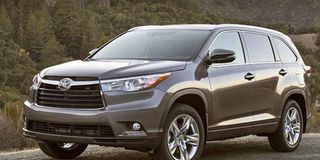Prime
The Kluger is a perfect family car

What you need to know:
The Toyota Kluger is popular among different motorists for reasons such as passenger space and off-road performance
Sheilla Nagawa
I love my Toyota Kluger, which I have had for three years, because it is spacious. It is the perfect car for our family travels since it can accommodate seven passengers, including the driver. My particular model runs on a 2400cc petrol engine that I find affordable when it comes to fuelling.
Before the rise in fuel prices, from my home in Kiwatule, Kampala, to Kampala City centre (a distance of about 11.2kms), I would use fuel worth Shs150,000 per week. Today, this has increased to Shs200,000.
The one shortcoming of the Kluger is that it is quite long and needs sizeable space to park, especially in the city centre where parking space is hard to find during weekdays. I sometimes find challenges when parking in reverse mode because some public parking spaces dictate how you park.
Mark Mugisha
I bought the Kluger because I wanted a car with good ground clearance with an all-wheel drive system to ease manoeuverability through upcountry roads. When driving on a slippery road, the power to move the heavy weight of the car is distributed in all four wheels. I have never skidded or got stuck by the roadside because the car has failed to move. To achieve this, I always make sure my tyres have treads.
When driving on the highway, with its 2400cc engine, I will drive 13km per litre of fuel and eight to 10 kilometres per litre in places with slow moving traffic in Kampala. When the speedometer crosses the 80km/hr speed mark, the weight of the car, which is an added advantage, keeps it stable on the road. The rear tyres appear as if they are bent and this makes it firm on the road as you increase speed.
Richard Wamala
I like the Toyota Kluger because of its off-road capability which is enhanced by its V6 3500cc petrol engine. When driving in Kampala with unpredictable traffic, I cover a distance of eight kilometres per litre of fuel, depending on how slow traffic is. On the highway, the mileage per litre increases gradually to 12km depending on how heavy the acceleration foot is.
Like most Toyota brands, it is one whose spare parts are readily available, especially at Kisekka Market in Kampala. The most expensive spare part I have replaced in the two years I have had the car were the shocks at a cost of Shs1.2m a pair.
On average, I spend Shs250,000 to carry out normal service of replacing the engine oil, spark plugs, air, fuel and oil filters, brake pads and other lubricants. Sometimes, the cost goes down to Shs180,000 when some parts such as the brake pads, fuel filters and spark plugs are still in roadworthy condition.
Being a high performance car, it is advisable to always read and interpret the signs on the car dashboard. The most dangerous one is low engine oil or check engine light that could lead to engine knock.
It is also important not to drive past the recommended mileage on the service manual. If you do so, the parts that would require replacement could cause damage to others and this means increased service cost.
Safety. A driver’s airbag, driver’s knee airbag, front passenger airbag, two side impact airbags and two curtain shield airbags which run all the way to the third row seats help protect the driver and passengers from impact.
Specifications
Fuel Tank Capacity (litres) 72L
Ground Clearance 201mm
No of doors 5
Gross Weight 2,690 Kg




